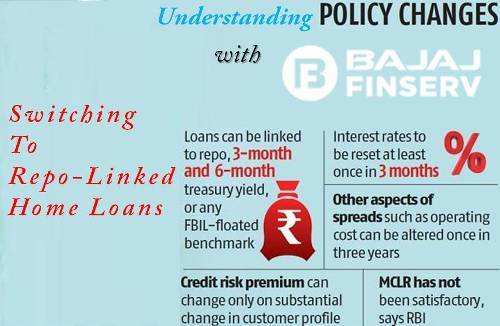Things to Know Before Switching to Repo-Linked Home Loans
On September 4 2019, RBI announced that it would be mandatory for lenders to switch over to benchmark rates set by the Central Government and RBI. Among this, the Repo Rate presents one of the most beneficial prospects for both lenders and borrowers

Lending market in India is dictated by two different factors – the Repo Rate, and the Marginal Cost of Funds based Lending Rate (MCLR). Among these two, the Repo Rate is the base rate that the Reserve Bank of India charges when they lend money to commercial banks across the country. It is also used by several institutions and authorities to control inflation.
On September 4 2019, RBI announced that it would be mandatory for lenders to switch over to benchmark rates set by the Central Government and RBI. Among this, the Repo Rate presents one of the most beneficial prospects for both lenders and borrowers.
RBI Repo Rate – an overview
- 35 basis points – Have been reduced from the previous Repo Rate determined by the RBI, reducing the overall interest rate of loans by a significant margin.
- 4% – Is the current repo rate of RBI.
- Every 3 months – I will see a mandatory revision of the interest rate for all financial institutions in India.
From 1 October 2019 onward, every financial institution has to shift to the benchmark rates, even for large-scale, secured credits like home loans and auto loans. As a customer, borrowers can opt to balance transfer switch over to Repo-linked home loans, which is likely to provide several benefits over conventional options.
Why switch to a Repo-linked home loan?
Repo-linked credits have been implemented by the RBI to offer better transparency and benefits for customers. Previously, lenders had the freedom to select their lending rate, which often missed out on the periodic changes to the Repo rates introduced by the Reserve Bank of India.
For example, between October 2018 and August 2019, the Repo Rate was 5.4% by the RBI, whereas the average rate of interest charged by several government-backed as well as private financial institutions stayed at an average of 8.4%* home loan rates. Expectations from the RBI Repo rate cut was an overall drop in the rate of interest in the financial year of 2018 – 2019. Unfortunately, customers could not benefit from the lowered percentage and had to pay on the basis of previous home loan interest rates.
What are the things to note?
- It will be introduced as an additional option
The new repo-linked rate will be presented as an additional option, so a borrower will have to choose between an MCLR-linked or repo-linked credit. The option will be provided during the home loan online application as well as an offline application process.
MCLR based loans will have their rates revised in accordance with any change in the MCLR, whereas repo-linked credits, including home loans, will be revised at least once every 3 months.
- There is an income cap on the transfer process
Only the borrowers with a minimum income of Rs. 6 Lakh per annum are eligible to apply for home loan transfer their credits to repo-linked loans. Existing customers can easily shift his or her line of credit to this product by paying a nominal fee.
- Transmission charges are automated
Any interest rate charges will be automatically transmitted to the retail borrower once they transfer their existing credits to repo-linked accounts. It will reduce the response time by a significant margin after any rate cut or increase.
The entire process will also become significantly more transparent for borrowers across the country. They will be able to track the changes and determine the new rates accordingly and calculate their monthly installment using tools like an EMI calculator. That will allow an individual to plan their finances more accurately.
- Rate reduction for NBFCs
Both NBFCs and housing finance companies will also be able to lower their interest rates once repo-linked home loans are imposed. Currently, these lenders cover almost 40% of the lending market, which ensures that a large number of individuals will be benefitted once the revised rate is introduced.
Some lenders also offer several borrower-friendly policies along with an affordable rate of interest for their credits. They also provide pre-approved offers that simplify the process of availing credit and help you save time. Such offers are available on both secured and unsecured credits, including advances like home loans, loans against property, personal loans, business loans, etc. You can check your pre-approved offer by sharing only some essential details online.
Repo-linked home loans are likely to bring significant benefits to both the borrowers and lenders, as the frequent revision and transparent policies will make the entire process streamlined and error-free. Remembering the above-mentioned aspects will help a borrower avail all the benefits with ease.
To join us on Facebook Click Here and Subscribe to UdaipurTimes Broadcast channels on GoogleNews | Telegram | Signal


